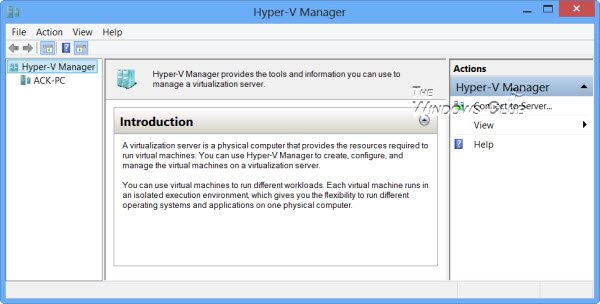
No major differences at the start of the new VM wizard.Īgain, the options are what you are used to. Let’s take a look at what is required to create Gen 2 VM, and then take a look at some of the differences between Gen 1 and Gen 2 VMs. First of all, the deployment is slower, but the second one is the need to remember to remove the legacy adapter after the VM is created. With the updated Hyper-V in Windows 8.1 Pro, one of the new capabilities is the Generation 2 virtual machines, which provide a number of benefits, but for me the big improvement is being able to do PXE installs into a VM at greater than 100Mb/s speeds, which is a common scenario for me and one that frustrates me for two two reasons. Being able to build dev and test VMs on your desktop, laptop or tablet, and then move them over to a high performance server without making changes is something that I take advantage of every week, so I definitely see the benefits. Choose “Programs and Features” from the list of options.The inclusion of Hyper-V in Windows 8 Pro and Windows 8 Enterprise was a huge benefit for those of us who work in environments where Hyper-V is the hypervisor of choice, which I guess also includes those of us who use Azure IaaS capabilities.

You need to press “Win+X” for launching the power user menu.

Once virtualization is enabled in BIOS, you may follow the steps mentioned below. If any of the above values are set to “No”, then it means that you need to enable virtualization in your BIOS settings. If the values shown in the window are all set to “Yes”, then you can proceed. The System Information window should pop up. For finding this out, open the Run dialog box by pressing “Win+R”, type “msinfo32” and hit the Enter button. How to Enable Client Hyper-V in Windows 8īefore you enable the Client Hyper-V, you must check whether your system is ready for virtualization. This shouldn’t be a problem on latest PCs. Your PC must have at least 4GB of RAM, and your CPU must support SLAT (Second Level Address Translation) technology. Prerequisites for Enabling Client Hyper-V in Windows 8

Moreover, this feature is only available for Pro and Enterprise users. It must be kept in mind that you can enable Client Hyper-V for 32 bit and 64 bit operating systems, but you can install and run it in 64 bit operating systems only. This article reviews how to enable client Hyper-V in Windows 8. The Windows 8 users can also utilize the Hyper-V feature for running virtual machines in it. Most of you would be familiar with VirtualBox and other VMware stations that allow you to run an operating system virtually inside another firmware, without physically installing it. Enabling Client Hyper-V in Windows 8 for Running Virtual Machines


 0 kommentar(er)
0 kommentar(er)
